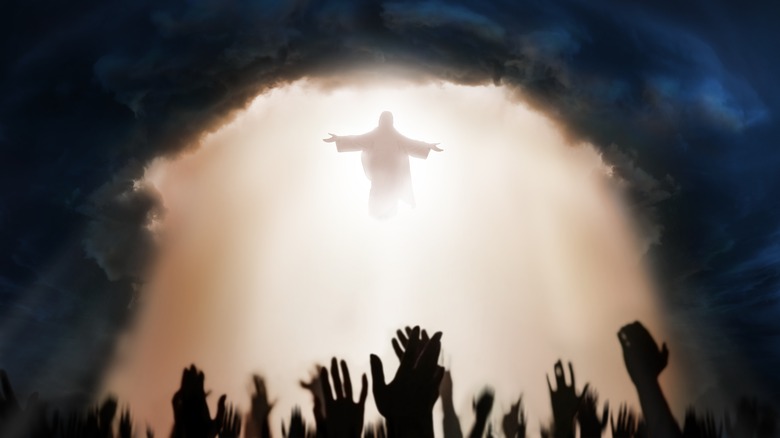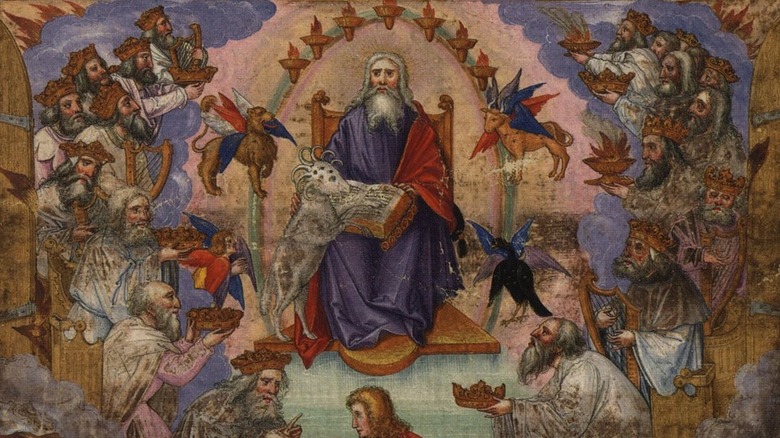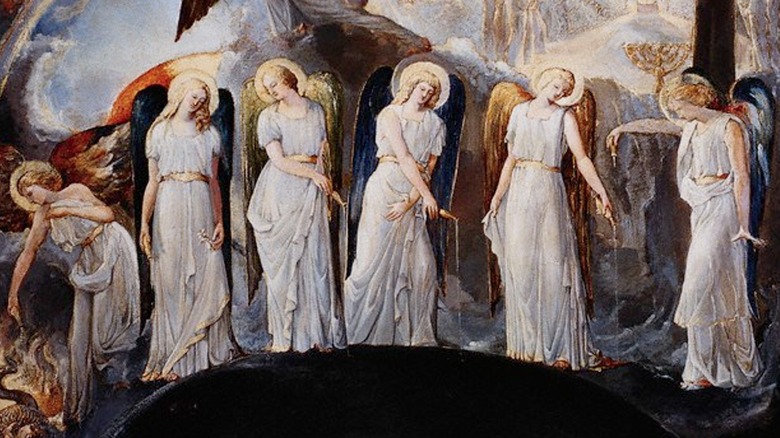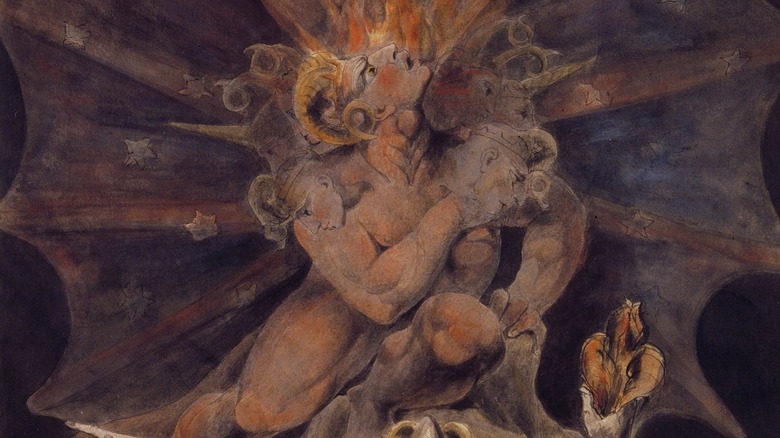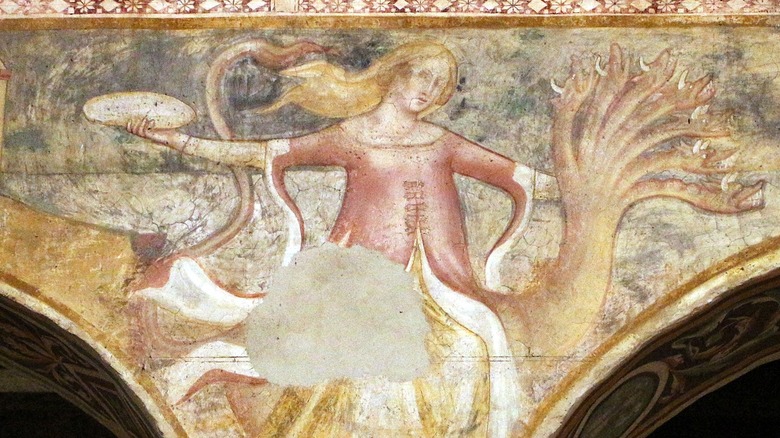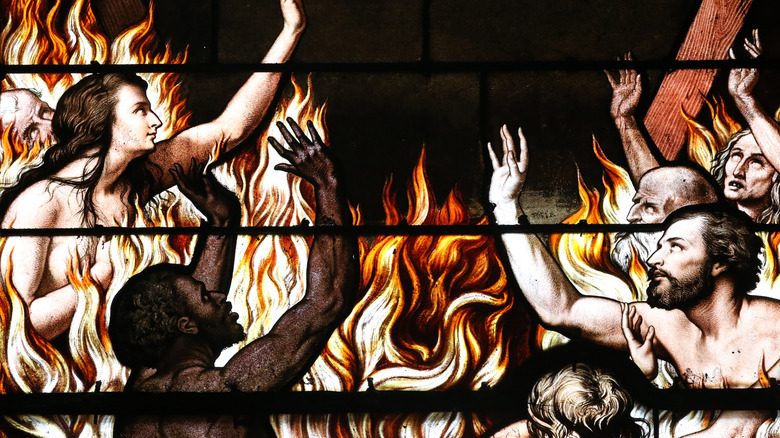Things About The Bible's Book Of Revelation That Don't Make Sense
It might sound hyperbolic, but without the Bible's Book of Revelation, there's no Christian story. Sin and redemption, the cleansing sacrifice of Jesus, the promise of an eternal afterlife with God: None of these really exist without the Bible's final book. Revelation describes the long-awaited return of humanity's savior, an apocalyptic showdown of good vs. evil, and describes proof beyond faith of Christian theology. It makes history deterministic and the future inevitable no matter what suffering the present entails. It creates the fundamental Western idea that time is moving towards something, changing, evolving, and finally, ending.
And the funny thing is: Revelation does all this using the most vague, poetic, and elevated language possible. It comes across like dream logic and seems impossible to take literally. Revelation 20, for instance, opens with, "And I saw an angel coming down out of heaven, having the key to the Abyss and holding in his hand a great chain. He seized the dragon, that ancient serpent, who is the devil, or Satan, and bound him for a thousand years." So, this means an actual angel carrying a literal key to a measurable abyss and wielding a physical chain to shackle a dragon and throw it in a celestial prison for 1,000 solar revolutions?
In other words, practically everything in Revelation is up for interpretation. On the surface, none of it makes much sense, including the much-anticipated rapture, God's seven seals, trumpets, and bowls of wrath, the beast rising from the ocean, the Whore of Babylon, and the nature of the final resting of the redeemed vs. the unredeemed.
The mysteries of the rapture
Nothing in Revelation makes sense without prior theological knowledge or some serious abstraction. Revelation 1 opens by presenting the text as a prophetic vision given to John of Patmos, an early church figure who might be John the Apostle. And of course, we all know how absolutely unclear prophecy is.
Enter the rapture: The moment when God rescues his followers before the hardcore apocalypse ensues. Thanks to the parroting of information over time, the 18th-century Puritanical "Great Awakening" in the United States, and modern fiction like the 16-book "Left Behind" series, the rapture's gotten reduced to a single idea: God snaps his fingers like Thanos from "The Avengers" films and poof goes the righteous.
But that doesn't happen in Revelation. The term "rapture" doesn't actually exist in the Bible and isn't explained clearly anywhere. Many ideas about the rapture actually come from passages in other biblical books like 1 Thessalonians 4 which talks about "the dead in Christ" rising following the "trumpet call of God" upon Jesus' return. Mark 13 relatedly talks about Jesus "coming in clouds with great power and glory."
Revelation remixes those ideas into its Second Coming of Jesus story. Revelation 20 says that those who had not "worshiped the beast or its image" (more on that later) "came to life and reigned with Christ a thousand years" and got spared some suffering. So is this the rapture? Where do these people go? Do we mean the physical dead or souls? What's supposed to happen, exactly? We've got no clue.
[Featured image by Matthias Gerung via Wikimedia Commons | Cropped and scaled]
The seven seals, trumpets, and bowls of wrath
End-of-days timelines mention biblical terms from Revelation that sound lifted from a dark fantasy series or death metal track: an ashen horse ridden by Death, the moon becoming like blood, a star named Wormwood, the king of locusts, and much more. And so we come to our next head-scratching revelatory mystery: Revelation's series of "seven" events: the seven seals, seven trumpets, and seven bowls. These events also connect to the famed four horsemen of the apocalypse and are bound into one series of catastrophes. From the text it's at least obvious that disasters are happening, but that's about it.
The seals (Revelation 6), trumpets (Revelation 8), and bowls (Revelation 16) — whatever they actually are — comprise three sequences of seven apocalyptic horrors described in Revelation that ravage the Earth. Jesus breaks the seals, angels blow the trumpets, angels pour the bowls of God's wrath, and each time something terrible happens.
The breaking of the seals summons the four horsemen — each one having an ability like the "power to take peace from the earth," given authority "to kill by sword, famine and plague, and by the wild beasts of the earth." Seal-breaking catastrophes include events like stars falling "as figs drop from a fig tree." Meanwhile, the trumpet section includes, "something like a huge mountain, all ablaze, was thrown into the sea." The bowl section includes, "three impure spirits that looked like frogs; they came out of the mouth of the dragon." In other words, specifics are impossible to understand and interpretations are practically endless.
[Featured image by British School Painter via Wikimedia Commons | Cropped and scaled]
The nature of the beast, 666
"The beast" and its number, 666, is an often-cited figure from Revelation. Many take this figure to be the Antichrist, which itself is an aggregate of Old and New Testament verses that cohered from around 1,000 C.E. Unpopular popes, Satan/Lucifer/the Devil, the generally un-pious: The Conversation explains that all of these and more have been described as the "Antichrist." The character comes equipped with centuries of cultural baggage, even aside from the lack of biblical clarity regarding the figure. Also, there are two beasts.
The beasts appear in the book of Revelation 13, which describes one beast coming out of the ocean and another the land. The sea beast "had ten horns and seven heads, with ten crowns on its horns, and on each head a blasphemous name." The beast "resembled a leopard, but had feet like those of a bear and a mouth like that of a lion." The chapter says, "All inhabitants of the earth will worship the beast – all whose names have not been written in the Lamb's book of life."
The second beast "was given power to give breath to the image of the first beast, so that the image could speak." The story went on to say everyone must "receive a mark on their right hands or on their foreheads, so that they could not buy or sell unless they had the mark." The mark was to be the mark of "the beast." The scripture says this scenario "calls for wisdom. Let the person who has insight calculate the number of the beast, for it is the number of a man. That number is 666;" another vague riddle left to interpretation.
[Featured image by The William Blake Archive via Wikimedia Commons | Cropped and scaled]
The Whore of Babylon
Next, we come to a character that's likely to raise some eyebrows: the "Whore of Babylon," aka the "Prostitute on the Beast", aka the "Mother of Prostitutes." Like the other items in this article, this character requires the reader to stretch into the symbolic and engage in some enormous leaps of reasoning.
The Whore of Babylon appears in Revelation 17 and 18 literally sitting on a beast — not the 666 beast. The writer describes being spiritually whisked away into a wilderness where sits "a scarlet beast that was covered with blasphemous names and had seven heads and ten horns." The woman sitting on the beast is "dressed in purple and scarlet, and was glittering with gold, precious stones and pearls. She held a golden cup in her hand, filled with abominable things and the filth of her adulteries." The words, "Babylon the great, the mother of prostitutes, and of the abominations of the earth" are written on her forehead. What follows is an incredibly confusing explanation about the number of the heads of the beast, including, "The beast who once was, and now is not, is an eighth king. He belongs to the seven and is going to his destruction."
Revelation 17 does finally say plainly at the end that the woman represents a city. Catholic Answers say that the city is an economic center. Cut to Revelation 18 and she's dead. "Fallen!," it reads, "Fallen is Babylon the Great! She has become a dwelling for demons and a haunt for every impure spirit."
[Featured image by Sailko via Wikimedia Commons | Cropped and scaled | CC BY-SA 4.0]
The Lake of Fire and the New Heaven
Although we have plenty of options left to choose from when describing things in Revelation that don't make sense, we should end on a topic so fundamental to Christianity that it's shocking how unclear Revelation is about it. Namely, the nature of Heaven and Hell. Or more specifically, the New Heaven and the Lake of Fire.
Folks tend to think of the events in Revelation resulting in the separation of humanity into two camps: those who go to Heaven (believers) and those who go to Hell (non-believers). But, Revelation 20 calls the final resting place for the damned the Lake of Fire, and Revelation 21 calls the final resting place for the holy the new heaven above the new earth, aka the Holy City, aka The New Jerusalem.
These verses imply that all those who've died until that point are hanging out in temporary resting places until the events of Revelation, wherein either their bodies and/or souls — it's not totally clear — get migrated to their final, eternal locations. The Lake of Fire isn't what we've come to call "Hell," a term and idea that doesn't actually exist in the Bible and developed over centuries of time into its modern concept — same as the New Heaven isn't the current Heaven.
Things are made even more unclear when considering the verbiage in Revelation 20 and 21, full of phrases like, "He who was seated," an angel who "showed me," "I saw" a throne, etc. How, where, and when? Such questions remain unanswered.
